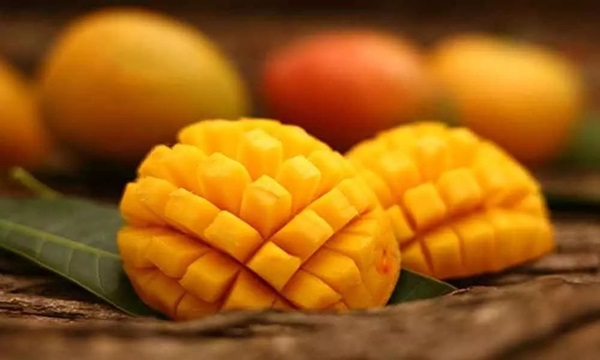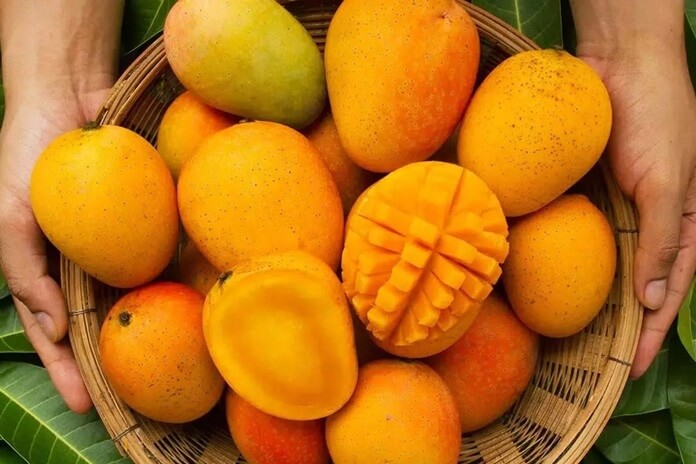It’s peak summertime, and we are excited to celebrate Mango Day on July 22! This yellow fruit is famous worldwide for its sweet and juicy flavor. Mangoes are summer fruits available in many shapes and sizes, and each variety offers a unique taste experience. In India, Pakistan, and Bangladesh, people often eat mangoes whole. They squeeze the fruit to turn it into a soft, mushy pulp and then make a hole in the skin to suck out the pulp. South Asia produces half of the world’s mangoes, with China being the second-largest mango producer.
Know The History of Mango Day
The mango has been cultivated for over 4000 years in India. This tropical stone fruit grows on a tree called Mangiferam which can reach up to 150 feet tall and lice for a very long time.
When young, the mango tree has orange-red leaves that eventually turn dark red and then a rich green. Mangos develop from the tree’s flowers and can take four to five months to ripen, starting green and hard.
There are over 500 mango varieties worldwide, many of which have been influenced by historical political, religious, and social events. As mentioned, mangoes were first grown in India and held special significance there.
The Buddha was often depicted sitting under a large mango tree, and Mughal emperor Babur decided to conquer India after tasting a particularly delicious mango. The Mughal Empire developed famous mango varieties like Chaunsa, Anwar Ratol, and Kesar.
Mangoes were so cherished by the empire that one emperor, Shah Jahan Zafar, punished his son for reserving and eating all the mangoes in the palace.

As time went on, mangoes spread from India to other countries around the world. Because mangoes have large seeds, they need to be transported by humans, unlike fruits like cherries, which can spread through birds and animals.
Traders and colonizers brought mangoes to Portugal and Britain. In South Asia, mangoes are highly valued and are considered the national fruit of Pakistan and India, and the national tree of Bangladesh. A basket of mangoes is also seen as a gesture of friendship in the region.
Also read, National Lollipop Day – July 20, 2024
| 4,000 Years Ago (First Mango Cultivation in the World) | Mangoes are cultivated for the first time in India. |
| 1886 (Evergreen Mango Trees Emerge as Survivors) | The disastrous freeze in Florida leads to many produce trees being destroyed except for the evergreen mango trees.1987 First Mango Festival |
| 1987 (First Mango Festival) | India’s tourism board commemorates the first International Mango Festival in the world. |
| 1990 (Fresh Produce Association’s Mango Promotion) | The Fresh Produce Association of the Americas starts promoting mangoes all over the country. |
5 Interesting About Mangoes
- According to Indian folklore, mango trees have the power to grant wishes.
- Mango is known as the king of fruits because it is the most widely.
- As if their amazing taste wasn’t enough, mangoes are also a superfood packed with vitamins and minerals.
- Unripe, green mangoes have more vitamin C than ripe mangoes.
- Mangoes are close relatives of pistachios and cashews.
Frequently Ask Question
National Ice Cream Day – July 21, 2024
Mangoes contain an enzyme that breaks down protein, aiding in digestion. they are also rich in prebiotic dietary fiber, which supports gut health and overall well-being.
What Happens If Mangoes Float in Water?
If mangoes sink in water, they are naturally ripe. However, if you see a mango floating on the surface, it likely has been treated with chemicals to make it look ripe.
What Chemicals Are in Mangoes?
In mangoes, ethyl-2 methyl propanoate is one of the most abundant volatile compounds. This chemical is responsible for the fruit’s distinctive scent and flavor, giving mangoes their sweet, fruity, and slightly floral aroma.
You may also like to read, National Ice Cream Day – July 21, 2024
